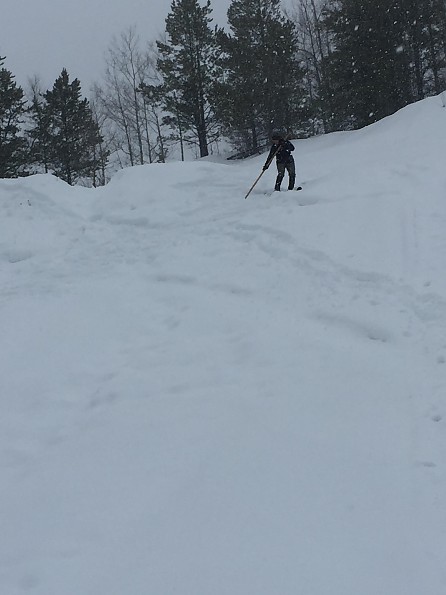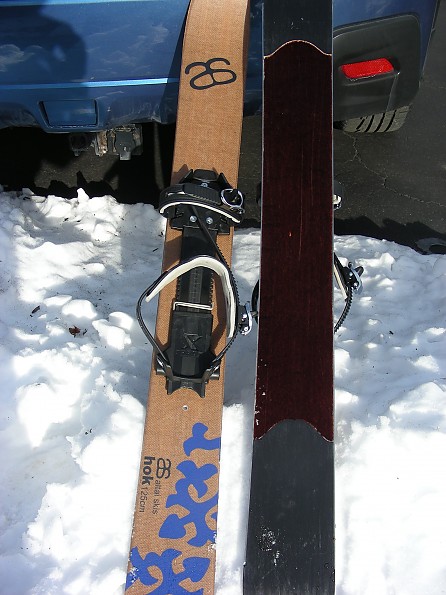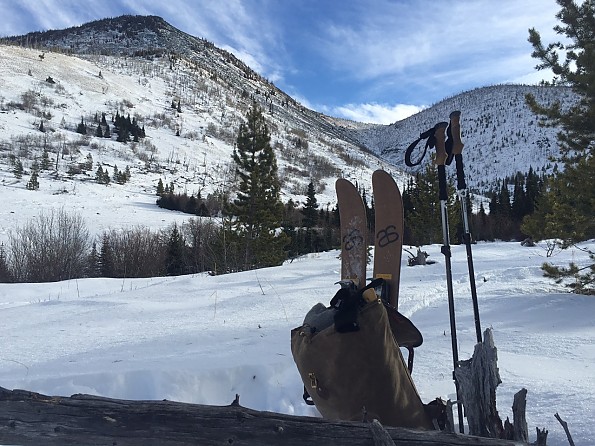Altai Skis Hok

Middle Aged Couple loves their Altai Hok Skis.
Pros
- Easy to use
- Universal bindings
- Xlimb moderate hills with little effort
Cons
- A bit expensive
- Not widely available
- Not as great on groomed trails, especially with hard crust
I bought one pair of 145cm Hoks and one pair of 125cm Hoks, both with universal bindings, for my wife (54 yrs and 135lbs) and myself (58 yrs and 185lbs). My wife has moderate downhill skiing experience, and I have never been on skis. We bought them to explore our property in Alaska February 2024.
My wife was hesitant at first, but quickly adapted to the skis, now says she would choose them over any standard skis for general use. I was convinced they were the best ski for us before I purchased them, and I have not been disappointed overall.
We began breaking trail in 5' of sugary powder (like sugar all the way to the ground), neither of us sank more than 3-6" in the fresh powder. As expected, following the trailbreaker is much less effort, but even breaking trail we didn't get terribly tired. I now have about 12 hours on mine, she has about 6 hours on hers. I have used them much more in the deep powder, and I have used them on a powdery groomed trail without her.
This morning we ski-shoed a nordic trail about 3 miles long. The temps are up and there was a firm crust, but the trail was groomed recently and other than moose prints and a few ski marks, the trail was in great condition. They were quite slow down slight hills, but absolutely rock uphill (in powder they rock uphill and downhill and track much better). After the trek my groin was a bit sore because of the muscle (largely unused until this point) controlling the skis. I am sure 3-point bindings and rigid boots would make them track better and lower the workload on my groin muscles.
My wife was pleased with the performance of her skis all-around. We were using normal ski-poles most of time we used the skis. I will buy the skis again, and recommend them to anyone looking to ski-shoe.
One improvement I think is to make the skins proportionate to the length. The skins on the 125cm and 145cm are the same, so my wife gets less glide than I, especially in groomed conditions. Amazing transportation even with that small descrepancy.
My wife just reminded me of the noise. On the crust today (or packed trail for me yesterday), they are quite noisy and it is difficult to hold a conversation unless side-by-side. With no experience for either of us in this discipline, I can't call that a problem because I just don't know. Our technique could also contribute substantially to the noise. They also make a "zipping" noise on groomed trails, probably due to the skins, but also the edges.
Background
No previous experience
Source: bought it new
Price Paid: $400/pr
These are a lightweight, maneuverable way to get off the beaten track and have snowfun. If you can walk, you can Hok :)
Pros
- These are definitely a hybrid that kind of create their own niche.
- Reasonably lightweight
- They’re easier to glide along in than snowshoes (slide forward instead of lifting).
- Easy to strap into if you get the universal binding
- Very portable
- Will take major abuse (rough terrain)
- Easily walk up slopes regular cross-country skis need to traverse, herringbone, or sidestep up
Cons
- The built-in skins that give traction create drag making a ‘kick n’ glide’ motion a bit more work.
- Temperatures that are in the just freezing range can make for ice/snow buildup. This can be managed to some degree by silicone spray or something like Swix FX4.
I’ve had three seasons of Hok experience now, two with the Universal Binding, one with the three-pin binding.
I find the Hoks to be superb for exploring. My wife and I enjoy wandering up frozen stream and river beds. The Hok has enough traction to climb up and enough glide to slide down. They offer a maneuverability in tight terrain my cross-country skis struggle in, a bit more speed/less effort than my snowshoes require, and an opportunity to "run" in powdery snow.
The Universal Bindings are functional. They allow you to use regular boots (I tried them with Fivefinger shoes, it worked but I wouldn’t recommend it) and have fun. I found it beneficial to stop on occasion and tighten up the straps. When I changed my binding over to a three pin it was a game changer—far superior control and efficiency, much less wasted effort.
Using a Lurk (aka Tiak) for descending is highly recommended if you’re not skilled in Telemark technique. It’s also extremely fun and controllable to ski "tripod". I plan on finding/fabricating a two-piece Lurk for the upcoming season as I want more alternatives available than poles or a one-piece Lurk.
My Hoks are 145’s (I’m 6', 200 pounds), my wife’s are 125’s (she’s 5', 110 pounds). My flotation is adequate, hers is superior.
Wife on the Lurk in powder...
Wife carving downhill...
Us exploring (using my Hoks as a bench).
Background
I do resort, some backcountry, and lots of XC skiing. I’ve used the Hoks for three full seasons in varying conditions/terrain. They’ve provided a lot of fun and memorable moments. I wouldn’t hesitate to replace them.
Source: bought it new
Price Paid: Hers $400 Canadian with Universal binding, Mine $275 Canadian without binding.
True to their description, these are a cross between x-country skis and snowshoes and just might be the right choice for many for winter travel in the front and backcountry.
Pros
- Easy to maneuver
- Skins do a good job in climbing
- The universal bindings work well
- You have several binding options
Cons
- In steeper and icier conditions they need more traction
I rented a pair if these from a local shop to give a whirl. I rented 125's that were mounted with BC NNN bindings, I happened to have a pair of boots that worked so off I went. They were easy to maneuver with, they climb nicely, and on the way out I shaved a lot of time off versus snowshoeing.
I did go down a couple a couple of times, but I'm not an accomplished skier, far from it. I enjoyed them enough that I bought a pair of my own; I ended up going with the universal bindings. I think if I was more of a skier I'd opt for a three pin and cable setup.
My hope is with some practice the skiing skills will pick up for me and if need be I can swap in a different binding setup (they are easily setup with three pin, NNN or their universal binding).
There are limitations to the ski. It won't get me into all the places that I go with my MSR Lightnings. They simply don't have the traction that an aggressive snowshoe crampon/deck offers. I think with a little ingenuity, you could come up a with a removable crampon which would add range to these skis.
If you have snowshoed before these will seem pretty familiar. If you also happen to be a good skier you'll probably be even more pleased.
So far I'm really pleased with the Hoks, hoping with a bit more practice on the skiing end I'll be even more pleased :)
Source: bought it new
Price Paid: $259
Breaks the cycle of upgrading boots and skis with downhill and cross-country as bindings are universal and ski lengths are only two. Great fun, easy to use by adults and juniors, see detailed review on the Adirondack Mountain Club website (link below).
Pros
- fun on most snow conditions
- makes snowshoes obsolete
- no special ski boots necessary
- easy to use by beginners, experts
- great for seniors too
- very inexpensive for ski gear
- durable, lasts for years
Cons
- earlier binding subject to failure
- limited availability
- so much fun tires you out...

For a detailed review, see Gear Review: Altai Hok Skis on the Adirondack Mountain Club website in the News section.
Background
Have had for 4 years and still having fun!
Source: LL Bean which guarantees the product
Your Review
Where to Buy
You May Like
Specs
| Price |
MSRP: $249.95 Current Retail: $399.95 Historic Range: $216.95-$399.95 Reviewers Paid: $259.00 |
||
| Sizes |
125 cm, 145 cm, and Balla Hok 99cm kids version |
||
| Materials | sustainable paulownia wood core reinforced with a combination of organic natural fibers and fiberglass | synthetic climbing skin integrated into the base of the ski, steel edges | |




